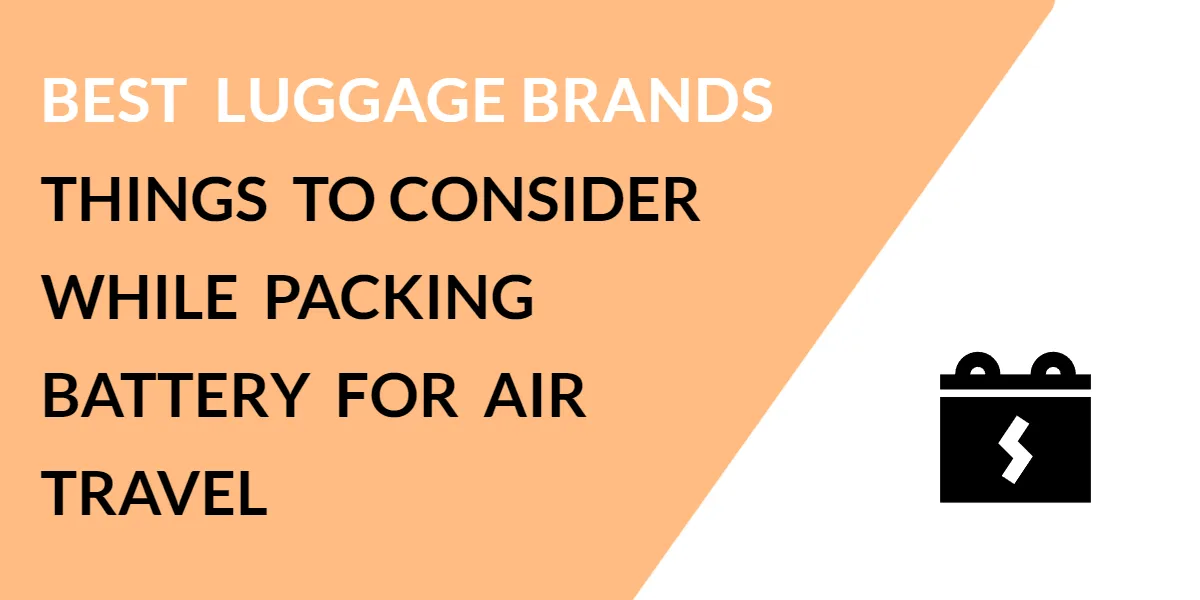Thousands of people travel through airlines with electronic items like toothbrushes and laptops, which contain batteries that fall under dangerous goods.
Airports authorities have provided clear guidelines but many people get confused about what kind of batteries in luggage are allowed and in what form.
In the article below, I have explained what airport authorities look in batteries, the types of batteries, their allowance, and more.
Things Airport Authorities Consider For Batteries
Based on the factors below airports and security authorities consider to either allow a person to carry battery or not. The purpose of mentioning these factors is to educate readers to categorize battery type and allowance instantly.
Type Of Battery
Lithium, Alkaline, or Lead: Lithium batteries are common in gadgets but need special attention due to risks. Alkaline and lead-acid batteries have their own sets of rules.
Battery Size
Small or Large: Small batteries, like those in your phone or laptop, are usually fine in carry-on luggage. Large batteries, especially those over 100 watt-hours, might need approval from the airline.
Installed or Spare
Installed in Devices: These are typically allowed in carry-on baggage because they are considered safer when installed in the device they power.
Spare Batteries: These must be in your carry-on baggage, not checked baggage, to keep an eye on them and reduce the risk of problems.
Rechargeable or Non-Rechargeable
Rechargeable (like Li-ion): These are okay in carry-on luggage, but there are limits on their size and quantity.
Non-rechargeable (like Alkaline): Generally allowed, but checking for specific rules is always good.
Risk Factors
Risk of Heating: Batteries that can get hot pose a fire risk, so security checks if they’re packed safely to prevent short circuits. If your battery heats up quickly, then you should keep it at home or report authorities.
Physical Condition: Batteries shouldn’t be damaged or leaking, as this increases the risk of issues during the flight.
Quantity Allowed
There’s usually a limit to the number of spare batteries you can carry, depending on the chemical compositions like lithium and the size of the battery. Batteries are allowed in limited quantities for personal use only.
For commercial usage, they may need paperwork or something which I am not gonna cover.
Packaging
Spare batteries need to be properly packed to prevent short circuits. The objective is to cover the battery terminals with non-conductive objects to prevent current flow, and eventually catch fire.
Airline and Destination Rules
Different airlines and countries might have additional rules or restrictions, so it’s smart to check with your airline and the aviation authority of your destination.
Approval for Exceptions
In some cases, if you need to carry batteries that exceed the standard limits, you’ll need to get approval from the airline ahead of time.
Security Screening
All batteries and devices are subject to security screening. Security personnel might ask you to power up your devices, so ensure they’re charged.
Types Of Batteries And Allowance
Dry Alkaline Battery
These batteries are disposable and are mostly used in simple electronic items like remotes, watches, and toys to provide sustainable current for quite some time.
You have different size variations for electronic items like A, AA, C, D, and 9 volts. These batteries are safe to use and have an almost low risk of heating and explosion if kept properly.
Dry alkaline batteries must be kept at room temperature and ensure no damage or puncture. If so, you should not carry it on an airplane.
These batteries are allowed in both cabin and checked baggage, whether in spare form (terminal protected) or installed in some electronic gadget.
Dry Rechargeable Battery
Dry rechargeable batteries are eco-friendly options that power electronic items like trimmers, flashlights, etc.
These are almost similar to disposable batteries in terms of size and power capacity, but they have a relatively higher chance of risk, especially in installed batteries due to overcharging.
The FAA also allows rechargeable batteries in both cabin and checked baggage, if these batteries are not damaged and their terminals are well protected.
Lithium Ion Batteries
Lithium-ion batteries with a power capacity of up to 100 watts are used in laptops, cameras, and power tools. Compared to common batteries, these batteries tend to catch fire due to overcharging or heat.
Cabin luggage: Allowed in both spared or installed form.
Checked Luggage: Batteries are not allowed in spare form. Installed batteries (except E-cigarettes) are allowed in devices like laptops, cameras and others.
Larger Lithium Ion Batteries
Lithium batteries with a capacity of 100 to 160 watt- hour are considered larger lithium-ion batteries. For this kind of battery, you need to check the rules from your respective airlines and whether they allow it.
Generally, two large lithium batteries are allowed in the cabin area, provided their safe packaging. For checked areas, these batteries are allowed in installed conditions(if the airline allows) and not in spared form.
Lithium Metal Batteries
Lithium metal batteries are not rechargeable and are mostly used in electronic watches and cameras as disposable, like dry alkaline batteries.
You can carry it in the cabin area in an installed or spare form, and for checked luggage, you need permission for an installed form, and the spare form is not allowed.
Non-Spillable Wet Batteries
Nonspillable batteries often used in cars to power their engines are made of metals and require chemicals to function. Each person can carry 12 volt/100 watt-hours of wet battery for air travel in either spare or installed form.
Just ensure its fluid is excluded, pack it to protect its terminal, and mark it as non-spillable on its box.
Special Considerations
Note: However, there are certain rules where you are allowed to carry the batteries in a bag after airline permission, but I would still recommend you pack them in a handbag.
Aircrew personnel are trained for panic situations, and it would be easier for them to handle them if the battery caught fire. In cargo areas, no one can go there during the flight, which might result in a dangerous situation.
Another thing you need to consider is the electronic tool you are carrying; airline authorities probably do not allow such tools that are capable of causing harm of any kind.
It is always recommended to double check the airlines, government, and securities current policies for your batteries, so you won’t have to encounter a surprise at the airport.
How To Calculate Battery Power For Air Travel?
To calculate the power of your battery, determine in which category it falls in before packing. You need to use your brain and math to know this, and it is simple.
Formula: You can see at the back of the battery that two values are written; one with V, like 1.35V, and the other is Ah or mah.
To calculate Wh(Watt hours)= V(volts) x Ah(ampere hour)
For mah =, divide mah by 1000 to get ah and then perform the above calculation.
How To Pack Batteries In Luggage For Air Travel?
The whole idea of packing a battery is to protect both battery terminals from making any connection by any third conductor. Once the current starts to follow uncontrollably, it could become dangerous.
If you have a small battery, cover its terminals with plastic wrap or anything non-conductive. For wet battery, drain out its chemical water and cap its terminals.
Besides this, you also need to check whether your battery is cracked from anywhere and does not overheat unexpectedly. If this is the case, then you should leave it at home.
Number Of Batteries Allowed In Airplanes?
The number of batteries allowed on an airplane depends on two things: one, what kind of battery you are bringing, and second, what is your purpose?
For example, you can carry only two large batteries, like a lithium-ion battery with a capacity of up to 160-watt hours or a 100-watt hour non-spillable battery, if your airline allows.
However, you can bring any smaller batteries only for your personal use. If you bring these batteries in larger quantities for commercial purposes, authorities might confiscate them.
What If I Accidentally Left the Power Bank In Checked Baggage?
First, you should not leave batteries in a checked bag, especially lithium batteries. If you accidentally put it in a checked bag, report it immediately before boarding the plane.
Airport authorities have tools to detect such items and will exclude them from the bag if they find out. In the worst-case scenario, if your lithium battery got into the plane’s cargo area. Then, pray it does not catch fire. Otherwise, the pilot must perform an emergency landing, or it can hurt many other people flying on board.
Here is recent news about a power bank that caught fire in a Hong Kong flight to give you an example of how batteries catch or explode. Luckily, it was in the cabin and was easily managed. However, it is not possible to handle such situations in the cargo areas during flight.










